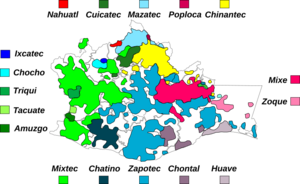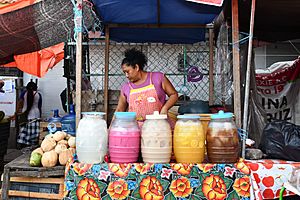Sexuality and gender in Zapotec Oaxaca facts for kids
This article explores how gender is understood in Oaxaca, a state in Mexico with many Zapotec individuals. It looks at their unique traditions and roles.
Contents
Zapotec People in Mexico
Mexico is home to many different groups of indigenous people. The National Institute of Indigenous Peoples has identified 68 such communities across the country. A large number of these groups live in the southern parts of Mexico, especially in the state of Oaxaca.
In Oaxaca, about 65.7% of the people belong to one of the 16 indigenous groups found there. More specifically, 57% of Oaxaca's population identifies as either Zapotec or Mixtec people.
The Zapotec people have lived in this region for a very long time, possibly as far back as 10,000 years ago. They speak languages from the Oto-Manguean family. In 2005, a study found that over 410,000 people in Mexico spoke Zapotec languages. A large majority of them, about 87%, lived in Oaxaca. These numbers show just how important the Zapotec people are in Oaxaca.
Understanding Gender in Zapotec Culture
Researchers like Lynn Stephen have studied how gender is seen in Zapotec communities in Oaxaca. Her work, including a study called Gender in Zapotec Oaxaca, looks at how history and daily life shape these ideas. She visited small cities like Juchitán de Zaragoza and Teotitlán del Valle in Oaxaca.
Stephen found that people in Oaxaca are very proud of their region, their traditions, and their indigenous roots. Many actively work to keep their culture alive. Her research often focuses on Zapotec communities, where people commonly speak Zapotec languages. These communities also recognize a third gender called Muxe, and they continue to hold important cultural events called velas.
Stephen's research also explores how things like people moving to new places, colonialism (when one country takes control of another), and social class have influenced how gender is understood. These outside forces have helped create specific roles for different genders and how these identities are shown in modern life.
Indigenous Gender Identity: Muxe
What is a Muxe?
The term Muxe describes an indigenous Zapotec third gender. This means they are not seen as strictly male or female. Alfredo Mirandé, in his article Hombres Mujeres: An Indigenous Third Gender, explains that muxes are:
"Biological males who also show feminine identities in their clothing and style, but they are not trying to become women. They see themselves, and are generally accepted, as a third gender. They are not men or women, but they adopt traits from both genders."
Muxes are considered a third gender because they do not fit into the usual male or female categories. They do not label themselves as either in any situation. Muxes also do not have a specific look. Some might wear traditional Zapotec female clothing and makeup, while others might prefer a more masculine style. There are no strict rules for how a muxe must look, but there are certain expectations that muxes and Zapotec women often share.
Gender Roles in Zapotec Communities
Within the Zapotec community, there are specific roles and responsibilities for women, men, and muxes.
Roles of Zapotec Muxes and Women
Work and Community Life
In places like Juchitán de Zaragoza, Zapotec culture is often seen as having a male-dominated structure, not one led by women. However, women often take on leadership roles and do much of the work in local businesses, such as markets and shops.
Both women and muxes are given responsibilities related to running these local markets. They are often involved in what is called "heavy work" and "intermediate activities." Heavy work includes preparing and running the markets and annual community gatherings known as velas. Velas are regional celebrations that last for several days. Women and muxes also prepare decorations for these events. They also share the task of embroidering clothing and decorating altars.
Researchers note that even though there are different roles for genders in the workforce, the hard work of women and muxes is highly valued. Being "hardworking" is often seen as a feminine quality. These observations show how roles are often divided between women and muxes compared to men.
Community Gatherings: Velas
Another important difference in roles between men, women, and muxes is seen during the traditional velas in Juchitán de Zaragoza. These annual events are described as "elaborate several-day celebrations involving processions, masses, food preparation and blessing, drinking, and dancing."
While everyone in the community works hard for these events, velas are often considered "women’s domain" because women do most of the preparation. Muxes are often responsible for making the traditional Zapotec clothing for those attending. These examples show some of the specific roles given based on gender during these important community events.
Muxe Representation in Media
The indigenous Zapotec community, its traditions, and the third gender of muxes are now being shown on social platforms like Netflix, Instagram, YouTube, and in magazines.
Documentaries that feature the lives of muxes include Third Gender: An Entrancing Look at Mexico’s Muxes | Short Film Showcase by National Geographic and Muxes -- Mexico’s Third Gender by The Guardian, both available on YouTube.
Muxes have also appeared on the cover of Vogue México in 2019. The December 2019 cover featured a portrait of Estrella, a muxe from Juchitán de Zaragoza. Estrella was also interviewed in The Guardian's documentary.
Finally, a muxe named Marven Lady Tacos de Canasta has become very popular on social media. She has many followers on Instagram and was featured in the popular Netflix series Taco Chronicles (specifically, Volume 1, Episode 3, "Canasta").




